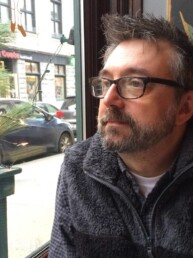One Ounce Opera is thrilled to revive this art song cycle for Here Be Monsters 2025 on Sunday, May 25 at 7:00 pm
Songs of Remembrance and Resistance
Part I: She Persisted (2017)

Composer Kevin March

Mezzo-soprano Veronica Williams

Soprano Amy Selby

Pianist Joseph Choi
Program Notes from the composer
On February 7, 2017, United States Senator Mitch McConnell (R-KY) attempted to silence fellow Senator Elizabeth Warren, during her statement on the floor of the Senate, opposing the confirmation of Jeff Sessions to the cabinet post of Attorney General. Sen. Warren had begun reading a letter Coretta Scott-King had written to the Chair of the Senate Judiciary Committee in 1986 opposing Sessions’ confirmation as a federal judge on the basis of his propensity for racial discrimination. Sen. McConnell interrupted her reading of the letter, invoking Senate Rule XIX, a seldom-used Senate rule which prohibits Senators from “impugning” one another’s characters.
In defense of his action, Sen. McConnell stated, “She was warned. She was given an explanation. Nevertheless, she persisted.” Rather than being accepted as an admonishment, the statement became a rallying cry for a grass-roots women’s movement already mobilized in opposition to the agenda of the White House.
This movement, the censure of Senator Warren and this rallying cry, served as the inspiration for this song cycle.
Principled women taking principled action in the face of patriarchal warnings, persisting in spite of fear, harm or threat of harm, are to be found throughout recorded history and across cultures. Though different in time and place and circumstance, they remained (or still remain) committed to a just course of action. They persisted. They persist.
One of the ever-present challenges of text setting is the use of a highly abstract medium to delineate that which is otherwise rather concrete and familiar. Sometimes the challenge is quite easy. For example: what music might suggest “love”? What music might suggest “war”? The repertoire is full of music about love and war. Sometimes the challenge is quite difficult. What music might suggest “persistence”? Most of us, to one extent or another, know “persistence.” We’ve experienced it to some degree; we know what it means, what it feels like. But when cast in pitches and rhythms and meters and melodies, what does it sound like? “Persistence” being the continuation of something in the face of difficulty or opposition, isn’t a particularly exalting or glamorous experience, although it may be inspirational and encouraging to others. It’s arduous, exhausting.
Reflecting on what I’d written after I’d completed the cycle, I found my setting of the line “She was warned. She was given an explanation. Nevertheless, she persisted,” to be somewhat ambiguous. In some passages it sounded admonishing to my ear while in others it sounded more like a quiet encouragement to “keep fighting the good fight.” My first impulse was to “fix” my setting of those lines, to re-set it as the heroic rallying cry of the movement it’s come to represent. I’ve decided however to let the settings be as they are, to let them sound admonishing or arduous on occasion in the hope that the listener might experience a bit of what millions of others have experienced: the transformation of the sting of admonishment into a drive and an oath to persist.
Notes on the Text
The text used in this cycle is drawn from auto-biographical testimony of an event or experience with only two exceptions: 1) the text for Klara Baić is a historical account recast in the first-person, and 2) the line “She was warned. She was given an explanation. Nevertheless, she persisted,” the source of which is previously noted.
The text used in “Hiding Them” is derived from comments made by unnamed sources.
Women Who Persisted*
On December 1, 1955, Rosa Parks refused to give up her seat on a Montgomery, Alabama city bus to a white passenger. She was asked to give up her seat. She refused. She was warned that she would be arrested if she did not give up her seat. She again refused and she was arrested. Her non-violent resistance led to an 11-month boycott of the city bus and eventually a U.S. Supreme Court ruling that segregation on public buses was unconstitutional.
In 1991, at the age of 9, Ilhan Omar and her family fled their home in Somalia due to the Somali civil war. They took refuge in Kenya where they lived in a refugee camp for the next 4 years until they emigrated to the United States in 1995. In 2016, she was elected to the Minnesota State House of Representatives and became the first Somali-American lawmaker in the U.S. While attending a White House policy forum in Washington D.C. on December 6, 2016 she got in a cab and was subjected to a barrage of racist, sexist, and Islamophobic insults and threats hurled at her by the cab driver. She used the incident to draw attention to the work that continues to be necessary in combating bigotries of all kinds.
Klara Baić was a Serbian, Catholic, housekeeper who quietly hid two Jewish brothers Mirko and Paul Deneberg during World War II, ultimately saving them from the concentration camps. On February 18, 2007, Klara Baić was named among the “Righteous Among the Nations,” the highest honor awarded to non- Jews by the state of Israel, given in recognition of life-saving efforts during the Holocaust.
Harriet Jacobs was born into slavery in 1813 in Edenton, North Carolina. In 1835, at the age of 22, after having given birth to two children, she escaped her owner and hid, for nearly 7 years, in a small cramped attic space above the ceiling of her grandmothers’ storage shed. When the opportunity came for her to escape via the underground railroad to the North, she took it, leaving behind her two children and other relatives. Once her freedom was secured in the North, she began making arrangements to retrieve her children. Even after she arrived on free soil, her freedom was not guaranteed until 1852 when the wife of her employer “purchased Jacobs’ rights” from the descendant of her original owner.
*And a few who may or may not be women. As of 2017, in the Southwest United States a new “underground railroad” has taken shape to hide and protect undocumented immigrants from deportation and to move them safely to one of the many sanctuary cities around the country. Both churches and individuals have been instrumental in the protection of at-risk individuals. The methods used to hide and transport them are much the same as those used to hide and
smuggle Jews and runaway slaves to safety.
-Kevin March


